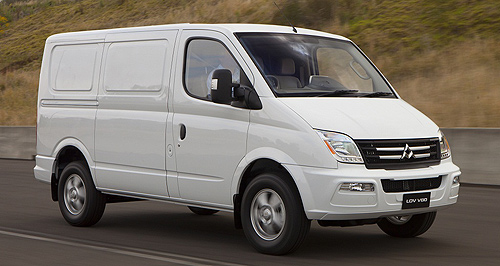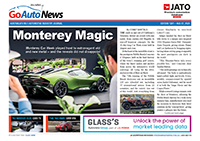Make / Model Search
New models - LDV - V80First drive: Chinese LDV vans arrive from $32,990Van plan: Chinese brand LDV will price its range of commercial vans below that of its key rivals from Korea, Japan and Europe. LDV V80 van range first step for Chinese auto giant SAIC in AustraliaGallery Click to see larger images 24 Jan 2013 AUSTRALIA’S first Chinese-made van – the LDV V80 – will beat key Korean, Japanese and European rivals on cargo capacity and specification while undercutting them by thousands on sticker price. That’s the word from Australian LDV distributor WMC, which this week staged the overdue local launch of the V80 short- and long-wheelbase commercial van range, priced from $32,990 plus on-road costs for the SWB, $37,990 for the mid-roof LWB and $39,990 for the high-roof LWB. Sydney-based WMC already imports trucks from separate brand JAC, and Higer commercial buses. At launch, the V80 will sell through a network of 37 commercial or passenger-oriented dealers spread throughout NSW, Victoria, Queensland, ACT, WA, SA and Tasmania. WMC says it has 210 V80s in Australia, with several hundred on a boat. General manager Shannon Taylor told GoAuto local supply was not restricted, with SAIC able to satisfy demand should it outstrip modest initial targets. The introduction of LDV – the fifth Chinese car brand to hit Australia after Great Wall, Foton, Geely and Chery – also marks the first venture into the local market by government-backed Shanghai Automotive Industrial Corporation (SAIC). SAIC, which also owns the famous MG brand that is in-line to return to our shores in the near future, is China’s largest car manufacturer, and purchased the rights to the V80 when it bought the van’s original developer and manufacturer – British firm Leyland Daf – in 2009. WMC chief executive officer Neil Bamford said the combined industrial might of Chinese giant SAIC and the V80’s European origins meant it would not simply be a price-point proposition, but could rather match its main rivals in terms of build quality and comfort. The limited launch line-up is powered exclusively by a Euro 4 100kW/330Nm 2.5-litre turbo-diesel engine built in China and licensed from Italian firm VM Motori, matched to a standard five-speed manual gearbox driven through the front wheels. All versions comes with dual airbags, all-round disc brakes and brake assist, but side airbags and stability control will not join the range until the end of the year at the earliest. There is no official NCAP safety score, but WMC claims SAIC’s own tests indicate a likely four-star result. WMC claims both petrol and automatic versions – the latter likely to be a ZF torque converter unit – will join the range within 12 months. People-mover and cab-chassis versions based on the V80 three-seater are also in the pipeline, either for late 2013 or early 2014. The SWB version is pitched squarely against the Hyundai iLoad diesel (from $34,490) and Toyota HiAce (from $36,990), currently Australia’s two best-selling vans. Unlike either of these models, the V80 comes standard with 16-inch alloy wheels, fog lights, dual sliding side doors with forklift access, cruise control and reversing sensors. All variants get 180-degree swinging rear barn-style doors. WMC also claims a payload of 1300kg – at least 180kg better than either – plus a larger cargo area and a wider, higher cabin. WMC claims a combined fuel economy figure on the SWB of 7.7 litres per 100km. The LWB ($37,990 or an extra $2000 for the high roof) version has the same standard features list and is aimed at European rivals such as the Ford Transit (from $43,990), Fiat Ducato ($42,490), Renault Master ($44,990) Volkswagen Crafter ($50,200) and even the Mercedes Sprinter ($53,490). Both LWB versions have tray long enough for two pallets and a payload of 1800kg (3500kg GVM). The cargo area measures 3300mm long, 1800mm wide and 1960mm high (in the high-roof version), with a capacity of 11.6 cubic metres. The slip-proof cargo floor in both the SWB and LWB versions comes with integrated wiring and either four or six tie-down points. The V80’s chassis features components made under license from ThyssenKrupp, ZF and Bosch, whole British organisation MIRA tuned the springs and shocks specifically for Australian conditions. Prototype models underwent testing here before going on-sale to iron out the kinks. Independent MacPherson struts at the front pair with twin parabolic leaf springs at the rear. The cabin includes eight-way seat adjustment, a tilt-adjustable steering wheel (but no reach adjustment), twin front airbags, four cup-holders, air-conditioning, USB and auxiliary connections, power mirrors and rear parking sensors. The V80 will also be the first van in Australia available with a factory backed and fully integrated wheelchair accessible option. WMC teamed up with Australia’s largest wheelchair conversion company – Byron Group – to offer the service, which makes dealers a one-stop shop. Previously, buyers wanted a converted van had to go through a third party once they had purchased the vehicle from a dealer. All V80s come with a three-year/100,000km warranty.  Quick testsRead more8th of January 2013  New CEO for Chinese vehicle importerChange at the helm for WMC Group as Jason Pecotic steps aside as CEO12th of November 2012  More Chinese vehicles delayedADR glitch sets back local launch of LDV vans until first quarter of 2013All new models Alfa Romeo Alfa Romeo Abarth Abarth Audi Audi Aston Martin Aston Martin BMW BMW Bentley Bentley Chrysler Chrysler Chevrolet Chevrolet Dodge Dodge Citroen Citroen Ferrari Ferrari DS DS Ford Ford Fiat Fiat FPV FPV Foton Foton Haval Haval Great Wall Great Wall Honda Honda Holden Holden Hyundai Hyundai HSV HSV Isuzu Isuzu Infiniti Infiniti Jaguar Jaguar Iveco Iveco Kia Kia Jeep Jeep Land Rover Land Rover Lamborghini Lamborghini Maserati Maserati Lexus Lexus McLaren McLaren Mazda Mazda Mercedes-Benz Mercedes-Benz Mitsubishi Mitsubishi Mini Mini Opel Opel Nissan Nissan Porsche Porsche Peugeot Peugeot Ram Ram Proton Proton Rolls-Royce Rolls-Royce Renault Renault Skoda Skoda Saab Saab SsangYong SsangYong Smart Smart Suzuki Suzuki Subaru Subaru Toyota Toyota Tesla Tesla Volvo VolvoV80 pricing
Motor industry news |
|






















Facebook Twitter Instagram